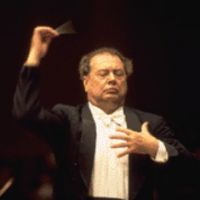
Berlioz' "Symphonie fantastique" Perfect Friday the 13th Valentine
What do you program for a Valentine’s Day concert that falls on Friday the 13th?

The Cincinnati Symphony Orchestra led by guest conductor Rafael Frühbeck de Burgos chose Hector Berlioz’ “Symphonie fantastique” and it would be hard to think of a better fit.
Berlioz’ 1830 programmatic work, inspired by his love for Shakespearean actress Harriet Smithson, tells the story of a hopelessly smitten musician (Berlioz himself) in some of the most romantic music ever written. Speaking of Valentine’s Day, the symphony was a gift from Berlioz to Smithson, whom he had not yet met. He invited her to a public performance in Paris, kind of like draping a valentine over the Arc di Triomphe.
That’s where Friday the 13th comes in. Though Berlioz and Smithson ultimately married, they lived unhappily ever after (they separated and she died in 1854).
The corrective on Friday’s program – and perfectly linked through the Bard – was Mendelssohn’s Incidental music for “A Midsummer Night’s Dream” (it’s also Mendelssohn’s 200th birthday). This gorgeous, universally popular music about love and hi-jinks in the world of fairies and elves contains none other than the Wedding March heard at nuptials the world over.
Spanish born Frühbeck de Burgos, 75, is one of the world’s most distinguished conductors. Now chief conductor/artistic director of the Dresden Philharmonic and with a large and enviable discography, he has long been a favorite in Cincinnati. Conducting completely from memory, the elegant, formally dressed maestro presided magisterially and affectionately over the CSO, which he clearly enjoys conducting. They made it mutual with a performance marked by clarity, precision and a kind of inspired integrity that elevated the music above all else.
Mendelssohn wrote 11 pieces for Shakespeare’s play. Heard Friday were the Overture, Scherzo, Nocturne and Wedding March. From the soft rustle of the Overture’s opening bars to the brassy conclusion of the Wedding March, it was music to savor. The bubbly Scherzo trailed away on Jasmine Choi’s flute, while principal French hornist Elizabeth Freimuth shone in the Nocturne, taken by Frühbeck at an animated but graceful tempo, gently tinged with passion.
Patrons enjoyed champagne, chocolates, roses and carnations at intermission (all for sale in the lobby) then returned for Berlioz’ phantasmagoric symphony.
Standing ramrod straight and tall on the podium, with the assurance of a European aristocrat, Frühbeck brought Berlioz’ controlled substance masterfully to life. Half of the "Symphonie fantastique" details -- according to Berlioz’ own program notes -- an opium dream, where the love-starved artist imagines that he has murdered his Beloved and paid the ultimate price, then sees her at a witches’ Sabbath.
The idée fixe – a recurrent, unifying theme, here representing the Beloved -- received a melancholy statement in the first movement, “Reveries, Passions,” where the turmoil of the artist is revealed. Frühbeck carved out the details with utmost care, whether following a dejected, downward thread through the strings or pointedly underlining the basses. The little threnody at the end, where the artist looks to heaven for comfort, was extremely touching.
Spooks leapt from the harp strings in the second movement (“A Ball”), which morphed into a merry waltz with a charming cornet solo, then a mad whirl. English hornist Christopher Philpotts sounded the Alpine melody which opens “Scene in the Country,” answered from the Music Hall gallery by oboist Lon Bussell for a realistic effect. This movement also featured a lovely solo by principal clarinetist Richard Hawley as clouds began to gather (four timpanists provided the thunder).
“March to the Scaffold” had a brassy edge as sharp as the guillotine, and the four CSO bassoons chortled merrily along, but Frühbeck dispatched the artist with the utmost dignity in a majestic final chord. He proceeded directly into “Dream of the Witches’ Sabbath,” a chaotic movement with a mocking E-flat clarinet solo (Jonathan Gunn) on a grotesquely transformed idée fixe, offstage bells announcing the “Dies Irae” (tubas and bassoons) and a final, furious fugue, with snarly strings playing on the bridge and with the wood of the bow. In a nice touch, Frühbeck let the flute and piccolo soar over the doomsday music at the end.
The CSO paid their visiting conductor a special tribute by refusing to stand and letting him take a well-deserved solo bow before basking in the collective ovation.
Repeat is tonight (really Valentine’s Day) at 8 p.m. at Music Hall. Tickets ($12-$95) at (513) 381-3300, or online at www.cincinnatisymphony.org.
(first published in the Cincinnati Enquirer Feb. 15, 2009)